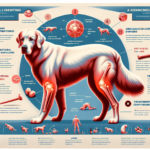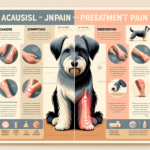American Water Spaniel Joint Pain: Causes, Symptoms, Prevention, and Treatment

Introduction
The American Water Spaniel (AWS) is a versatile and energetic breed known for its excellent hunting and retrieving skills. Originating in the United States, this breed was developed in the 19th century to be a proficient waterfowl retriever and upland game hunter. The AWS is characterized by its curly or wavy coat, which is water-resistant, and its medium size, typically weighing between 25 to 45 pounds. Known for their intelligence, loyalty, and friendly nature, American Water Spaniels make excellent companions for active families and hunters alike.
Like many breeds, the American Water Spaniel is prone to certain health issues, with joint pain being a significant concern. Joint health is crucial for this breed due to their active lifestyle and the physical demands of their typical activities. Ensuring the joint health of an American Water Spaniel can help maintain their quality of life and prolong their active years.
Breed-Specific Joint Pain Risks
Genetic Predisposition
The American Water Spaniel, like many purebred dogs, has a genetic predisposition to certain joint-related issues. Hip dysplasia is a common concern, where the hip joint does not fit properly into the hip socket, leading to pain and arthritis over time. Elbow dysplasia, another genetic condition, involves abnormal development of the elbow joint, causing lameness and discomfort. Arthritis, a degenerative joint disease, can also affect this breed, leading to chronic pain and reduced mobility.
Age-Related Risks
As American Water Spaniels age, the risk of joint pain increases. Typically, signs of joint issues may start to appear in middle age, around 5 to 7 years old. However, some dogs may show symptoms earlier or later, depending on their genetic makeup and lifestyle. It’s essential for owners to monitor their dogs for any signs of discomfort as they age and to take preventive measures to support joint health.
Activity Level and Joint Stress
American Water Spaniels are known for their high energy levels and love for physical activities such as hunting, retrieving, and swimming. While regular exercise is beneficial for their overall health, excessive or high-impact activities can put stress on their joints, potentially leading to injuries or exacerbating existing conditions. It’s crucial to balance their activity levels to prevent joint stress while keeping them fit and healthy.
Common Symptoms of Joint Pain in American Water Spaniels
General Symptoms
- Limping or favoring one leg
- Stiffness, especially after rest or exercise
- Reluctance to jump, climb stairs, or engage in physical activities
- Decreased activity level or lethargy
- Visible discomfort or pain when touched or moved
- Swelling or heat around the joints
Breed-Specific Symptoms
In American Water Spaniels, joint pain may manifest as a reluctance to engage in water activities or retrieve objects, which are typically their favorite pastimes. Owners may also notice a change in their dog’s gait or a decrease in their enthusiasm for play and exercise. These breed-specific symptoms can be early indicators of joint issues and should not be ignored.
When to Consult a Vet
If an American Water Spaniel shows any signs of joint pain, it’s essential to consult a veterinarian promptly. Early diagnosis and intervention can help manage the condition and prevent further deterioration. Owners should seek veterinary advice if their dog exhibits persistent limping, significant changes in activity levels, or any signs of pain and discomfort.
Preventive Measures for Joint Health
Exercise Recommendations
Regular, moderate exercise is crucial for maintaining joint health in American Water Spaniels. Activities such as swimming, walking, and controlled play can help keep their joints flexible and muscles strong without putting excessive stress on their joints. Avoid high-impact activities like jumping or running on hard surfaces, which can exacerbate joint issues.
Dietary Suggestions
A balanced diet rich in essential nutrients can support joint health in American Water Spaniels. Foods containing glucosamine, chondroitin, and omega-3 fatty acids are particularly beneficial for joint health. These nutrients can help reduce inflammation, support cartilage health, and improve joint function. Owners may also consider joint supplements, but it’s essential to consult a veterinarian before adding any supplements to their dog’s diet.
Weight Management
Maintaining a healthy weight is crucial for reducing joint stress in American Water Spaniels. Excess weight can put additional pressure on the joints, exacerbating pain and discomfort. Owners should monitor their dog’s weight and adjust their diet and exercise routine as needed to keep them at an optimal weight. Regular veterinary check-ups can help ensure that the dog remains within a healthy weight range.
Early Screening and Monitoring
Early screening and monitoring can help detect joint issues before they become severe. Regular veterinary check-ups, including orthopedic evaluations, can identify early signs of joint problems. For breeds like the American Water Spaniel, screening tests such as hip and elbow evaluations can be beneficial. Early intervention can help manage joint issues more effectively and improve the dog’s quality of life.
Treatment Options for Joint Pain
Non-Surgical Treatments
Non-surgical treatments for joint pain in American Water Spaniels include medications, physical therapy, and lifestyle adjustments. Anti-inflammatory medications and pain relievers can help manage pain and reduce inflammation. Physical therapy, including exercises and massage, can improve joint mobility and strength. Lifestyle adjustments, such as providing a comfortable bed and avoiding high-impact activities, can also help manage joint pain.
Surgical Options
In severe cases of joint pain, surgical interventions may be necessary. Common surgical options for joint issues in American Water Spaniels include hip replacement, elbow surgery, and arthroscopy. These surgeries can help alleviate pain and improve joint function. However, surgery should be considered a last resort after exploring non-surgical treatments. A veterinarian can provide guidance on the most appropriate surgical options based on the dog’s condition.
Alternative Therapies
Alternative therapies such as acupuncture, hydrotherapy, and massage can also benefit American Water Spaniels with joint pain. Acupuncture can help reduce pain and inflammation, while hydrotherapy provides low-impact exercise that supports joint health. Massage can improve circulation and reduce muscle tension, providing relief from joint pain. These therapies can be used in conjunction with traditional treatments to enhance their effectiveness.
Lifestyle and Management Tips
Daily Care Routine
A daily care routine for managing joint pain in American Water Spaniels should include regular, moderate exercise, a balanced diet, and joint supplements if recommended by a veterinarian. Owners should also provide a comfortable sleeping area with an orthopedic bed to support their dog’s joints. Regular grooming and monitoring for any signs of discomfort are also essential components of daily care.
Modifying the Home Environment
Making the home environment more comfortable for a dog with joint pain can significantly improve their quality of life. Consider installing ramps to help the dog navigate stairs or get onto furniture without jumping. Providing non-slip mats can prevent slips and falls, reducing the risk of injury. An orthopedic bed can offer additional support and comfort for sore joints.
Long-Term Management
Long-term management of joint pain in American Water Spaniels involves regular veterinary check-ups, ongoing monitoring of their condition, and adjustments to their care routine as needed. Owners should remain vigilant for any changes in their dog’s behavior or activity levels and consult a veterinarian if any new symptoms arise. Maintaining a consistent exercise routine, a healthy diet, and a supportive home environment can help manage joint pain and keep the dog active and happy.
FAQs About American Water Spaniels and Joint Pain
What are the early signs of joint pain in American Water Spaniels?
Early signs of joint pain in American Water Spaniels include limping, stiffness, reluctance to jump or climb stairs, and decreased activity levels. Owners may also notice changes in their dog’s gait or a lack of enthusiasm for play and exercise.
Can joint pain in American Water Spaniels be prevented?
While genetic predispositions cannot be entirely prevented, owners can take steps to reduce the risk of joint pain in American Water Spaniels. Regular, moderate exercise, a balanced diet rich in joint-supporting nutrients, maintaining a healthy weight, and early screening can help prevent or manage joint issues.
Are there specific exercises that are better for American Water Spaniels with joint pain?
Low-impact exercises such as swimming and walking are ideal for American Water Spaniels with joint pain. These activities help maintain joint flexibility and muscle strength without putting excessive stress on the joints. Avoid high-impact activities like jumping or running on hard surfaces.
What dietary supplements can support joint health in American Water Spaniels?
Dietary supplements containing glucosamine, chondroitin, and omega-3 fatty acids can support joint health in American Water Spaniels. These nutrients help reduce inflammation, support cartilage health, and improve joint function. Always consult a veterinarian before adding supplements to your dog’s diet.
When should I consider surgery for my American Water Spaniel’s joint pain?
Surgery should be considered a last resort after exploring non-surgical treatments. If your dog experiences severe pain, significant mobility issues, or if non-surgical treatments are ineffective, consult a veterinarian to discuss potential surgical options. The veterinarian can provide guidance on the most appropriate surgical interventions based on your dog’s condition.
Conclusion
Joint pain is a significant concern for American Water Spaniels, given their active lifestyle and genetic predispositions. By understanding the causes, symptoms, preventive measures, and treatment options, owners can take proactive steps to support their dog’s joint health. Regular veterinary check-ups, a balanced diet, appropriate exercise, and a supportive home environment are crucial for managing joint pain and ensuring a high quality of life for American Water Spaniels. By staying vigilant and consulting with veterinarians, owners can help their dogs remain active, happy, and healthy for years to come.




